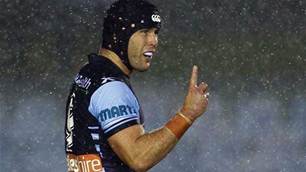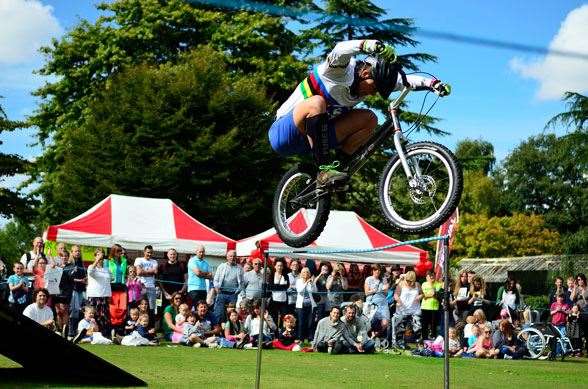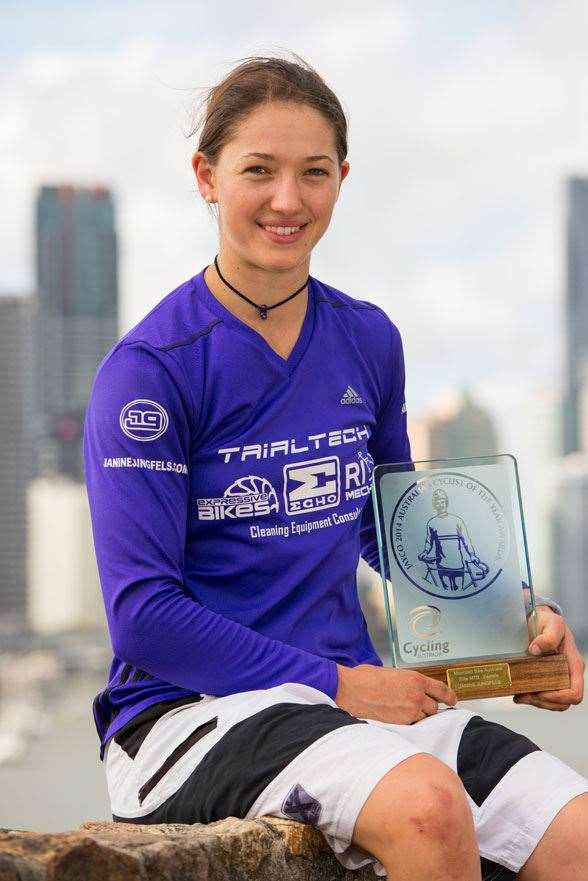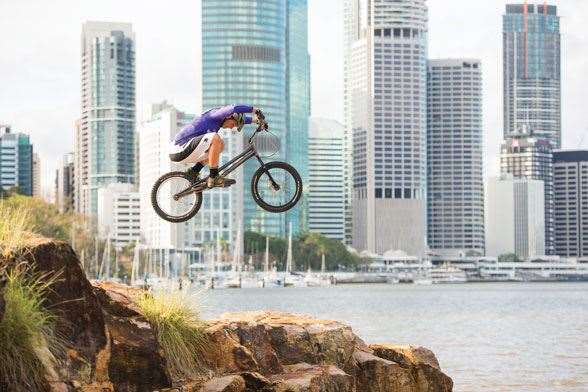How to excel at the quirky sport of trials riding.
Back in September, Australia had another cycling world champion crowned, in Andorra. Usually, such an esteemed addition would be hailed widely, especially in the lead-up to an Olympic year, as our worldbeater joins a distinguished roll call of rainbow jersey-wearers. But even Janine Jungfels calls trials riding the “quirky cousin of mountain bike riding” and understands if we missed it, though she’d like that to change – and we reckon her achievement deserves its place right alongside cycling’s superstars. Think gymnastics or parkour on two wheels and you get the idea: competitors traverse an obstacle course divided into sections, scoring points if they are forced to put their feet on the ground (one point one foot, five points two feet – yes, this is a sport where you DON’T want to score points). At the top level, it looks like it could slot into a Cirque du Soleil routine: the manoeuvres performed are astounding. In fact Jungfels is turning “pro” in a way, taking her show on the road with Eljay Freestyle Entertainment next year, performing throughout Queensland. Catch her act. At 27, the young woman from Brisbane is on top of the world. And it’s all her own work. She told Graem Sims how she did it.
BEGINNINGS
“As a kid I actually played soccer for about six years, until I was about 16, but I started getting fed up with that. Then I saw my first trials bike. A family friend had three sons, and the eldest son did motorcycle trials, but he also had a trials pushbike as well, just to help his motorcycle riding. And I was friends with his younger son, Morgan [Driessens]. So the older brother gave Morgan the bike, we both had a go, and we really enjoyed it. And so I went out and got a trials bike too and we started to go out every weekend riding. That was in 2005. I had owned a really basic mountain bike that I would ride to the shops, but until then I wasn’t a cyclist at all. After a couple of years’ riding I got pretty keen to compete, but with no female competition in Australia, I just worked my way through the male categories. Now I’m riding B grade – A grade is the top men, and they have a lot of power. In B grade the technical riding is quite high, but I don’t quite have the power of the men ... yet! It’s something I’m working on. I had my first international competition in 2009, when the World Mountain Bike Champion-ships were held in Canberra. And I finished fourth. Two weeks later we went to NZ for the World Cup, and that was my first meeting with all the world’s best riders that we’d only ever seen on YouTube. It was like meeting all these movie stars. Oh God, that’s Kenny Belaey! [laughs] So in Rotorua I came fourth again. I hadn’t known what to expect, so it was good to discover that I was competitive, and that sparked my motivation to train and get myself over to Europe, where the trials scene is much bigger. I couldn’t go in 2010 because I was still completing university and working, but I went over in 2011 and have been every year since. I can’t do complete seasons because of work commitments, but I’ll time it to do two World Cup meets around the time of the Worlds. So yeah, I finally won the world championship this year. It’s been the one title that has escaped me.”
COMPETITION
PREP
“I ride four times a week minimum, but I do a lot of cross training as well. I’m in the gym a minimum two times a week. I’m doing a strength and conditioning program designed by my personal trainer, Scott Arthy, at World Gym Brisbane. He introduced me to Olympic lifting, so I’ve been doing power cleans this year – it’s a very explosive move, the same movement you have jumping the bike. I can really feel it’s helped a lot. I’m also doing a lot of plyometric drills, like box jumps. And a lot of core work – in trials you get a very strong lower back but if you don’t have the antagonistic muscles at the front, in your stomach, you can get lower back pain. And because you have to catch your balance so often, a nice strong core helps. I do a lot of shoulder work as well, for when you’re doing the high jumps and the long jumps on the bike. I also get some mountain biking in as well every week, for the cardio, and I also do rock-climbing, bouldering, at least once a fortnight to strengthen the arms; the bouldering was mainly for my forearms. If you’re nervous in competitions, you’re often gripping the bars really tight – that’s when you can get what we call ‘forearm pump’. Sometimes your forearms get really pumped, really tight. It’s not quite spasming, it’s just so tight that it makes it difficult for you to control your forefinger, closing and opening, which you need for your braking. Bouldering really helps with that forearm strength, trying to reduce that fatigue.”
WHAT FEAR FACTOR?
“In competitions I’m not really worried about hurting myself; I’m more worried about making mistakes that are going to cost me my position. After ten years you know what you can and can’t do on a bike. If you are attempting a move that’s within your limits but close to your max, you’ll usually only get hurt if you don’t commit. So it’s actually safer to commit 100 percent to get it. When I first got to Europe I found that my riding level and physical condition was already at a high competitive level, and I knew I was capable of winning – just getting it done on the day was one of my biggest problems. So every time I’ve come home from Europe I’ve sat down and analysed my competitions, found out what my weaknesses were, and then just went and trained for that. This year it seems to have paid off. I also needed to get my mental frame of mind exactly sorted. I’m not into the voodoo sorts of things, it was more about having a more realistic view of the situation I was in – not having this expectation that I should be winning. In previous years I was like: ‘I’ve put all this work in, now I expect to get a result.’ But I think that hindered my performance. That expectation created pressure – but pressure’s just a built-up thing in your mind. It’s not real. This year I was more mechanical – I gave away my expectations. It was like, ‘Okay, you’ve done everything you can up to this point. You’ve trained hard, got yourself to the competition, you’re doing well, eating well, you know the bike’s running well, now all you’ve got to do is work and fight to the end and make sure you’ve done your best; if that’s enough, you’ve got the world title, and that’s great, and if you haven’t, well, you’ve just got to work a bit harder next year.’ So at the World Championships I was just fighting for every single section. The whole second lap I had forearm pump, which was making it difficult for me to control my brake timing. After the first section on the second lap I had a crash because I had the forearm pump and I cranked into my brake and flipped over the bars. And I thought, ‘Oh no, this is extra points!’ But then I just stopped and told myself: ‘I haven’t trained this hard and spent all this money to lose a world title just because of forearm pump on the day. I’m at the world titles, I need to make it through, I can’t make mistakes, you’re gripping the bars a little bit tight, just relax your arms.’ And it seemed to work. I did what I had to in sections to get through for a good ride, and yeah, I got the world title, so I was stoked.”
DIET
“There’s no point in training hard and feeding your machine bad food, because you’re not going to operate at your max. So I just make sure I’m eating well. I did some research about what I needed and spoke to a few people. I just eat healthy, unprocessed stuff. I just make sure I’m getting the right mix of protein and carbs to give myself the best possible chance I can. I drink heaps of water – and when training in hot conditions I make sure I have an electrolyte drink so I’m not dehydrating. These are just those easy things that most people know anyway. I don’t take supplements, mainly because of the doping risk. We are all tested. Every time you use something you’ve got to check the label and make sure there’s nothing illegal in them, and it’s a big hassle – too much work for me! I just eat clean.”
TOUGH ROAD
“This year I was accepted for a cycling grant, which covered my riding insurance and licence. But the majority came out of my pocket and from a few of my sponsors. My flights to Europe cost me $2000; I needed some help there so I started a crowd funding page – and I got support from strangers and randoms and people from the cycling community, people donating like 50 bucks, 20 bucks ... And by the time I left I got the $2000 – all those people helped make my world title happen. Thank you! Trials would be a great Olympic sport, but trying to convince the Olympics is another story. I guess time will tell. Right now we’re just trying to grow the sport and get more people into it. Because it’s all balance-orientated, all the skill and control that I’ve learnt helps me across all other sports, like mountain biking and wakeboarding. It is definitely useful for any kind of mountain biker.”
Related Articles

Training with the Cronulla Sharks' Michael Ennis

Training with the Cronulla Sharks' Michael Ennis
















